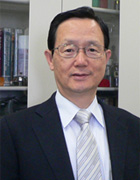Research Director

-
Ministry of Education, Culture, Sports, Science and Technology (MEXT)
FUTURE-PV Innovation
Reserch Director - Makoto Konagai
- Professor, Advanced Research Laboratories, Tokyo City University
The annual global production of solar cells reached 30 GW (30 million kW) in 2011. Meanwhile, however, the Japanese share of the global production of solar cells, which used to be 50%, dropped to around 15%. This was because of the rise of the low price solar cells manufactured mostly by companies overseas. The only way for us to compete against those companies is to develop high efficient, reliable, and highly innovative solar cells that cannot be imitated instantly by the turnkey systems. Materials for solar cells that are now in development include ones based on Si, Cu (InGa) Se2, CdTe, III-V compound semiconductor, and organic solar cells. Yet, since the production of about 1,000 GW of solar cells a year will be required after 2030, there is no doubt that silicon, which has no problem with the material supply, will be the mainstream material for solar cell productions in the future.
However, Si is a semiconductor with 1.1 eV band gap, way different from 1.5 eV band gap which is logically the most suitable band gap for converting solar energy. The energy conversion efficiency of silicon solar cells is about 25% and getting closer to 28% to 29%, which is considered the theoretical limitation. This research is aiming to realize a unique technology of “Si band gap using nano-wire” to break the physical limitation of band gap and drastically improve the performance of silicon solar cells. At the same time, this research tackles an extremely difficult challenge of realizing ultra-high efficiency with a tandem system of nano-wire silicon solar cell and heterojunction silicon solar cell. Based on these technologies, we aim to develop silicon solar cells with 30% energy conversion efficiency that breaks the conventional wisdom.
This project is implemented with the goal to develop the open and the most advanced research and development base in the world on renewable energies under the Basic Policy for Recovery and Reconstruction of Fukushima. Many excellent researchers from Japan and overseas will gather at the research facility that will be constructed in Koriyama, Fukushima, by the end of fiscal year 2013 and engage in unique and challenging research to realize nano-wire solar cells. The research outcomes of this facility in Fukushima will be widely transmitted throughout the world. Everyone involved in this project is committed to make maximum efforts to make Fukushima the hub of the research network of nano-wire solar cells and make this facility the top of nano-wire solar cell research in the world.
